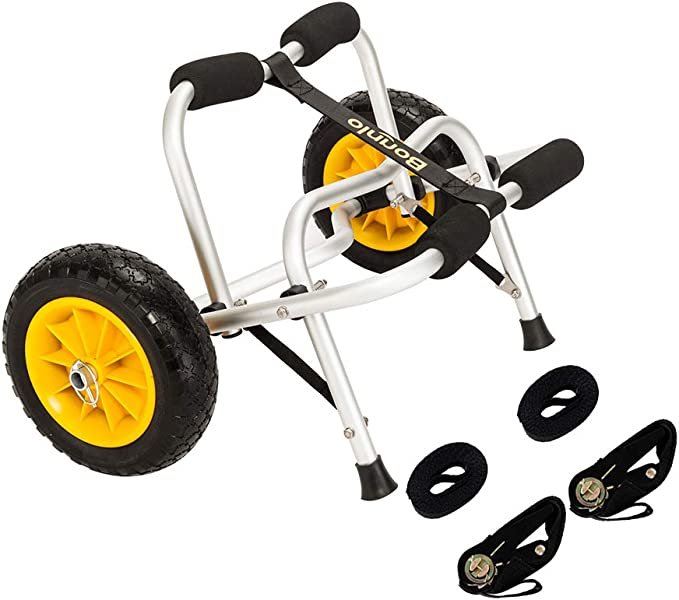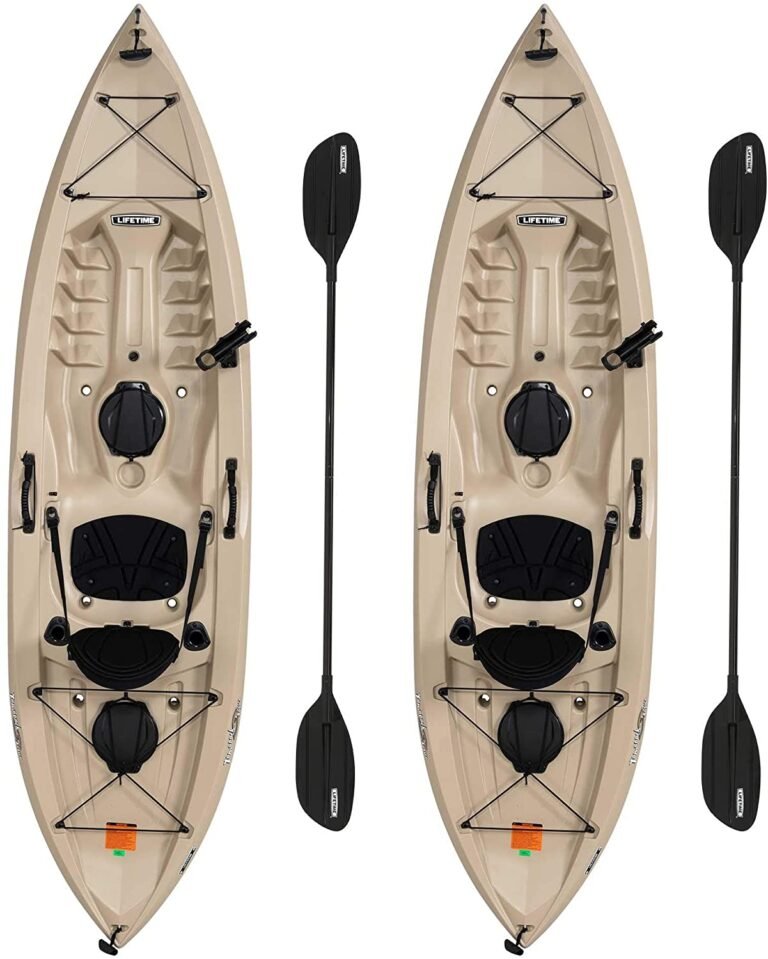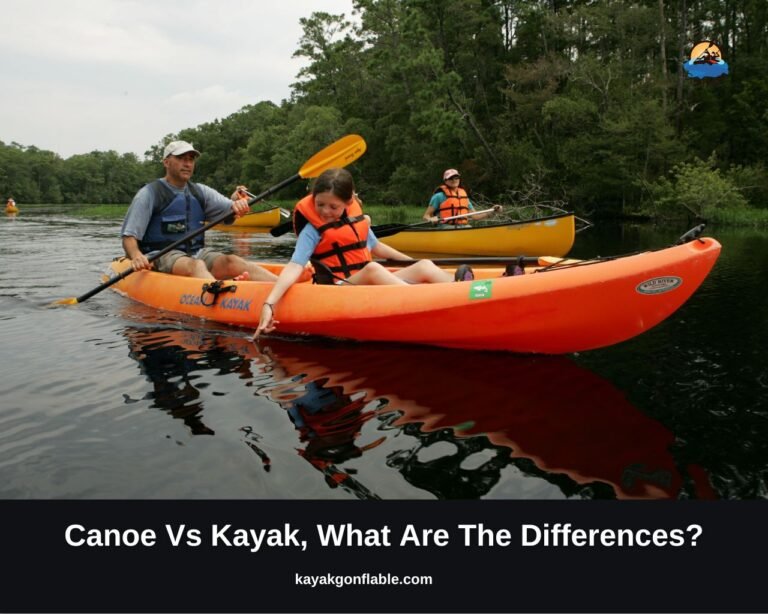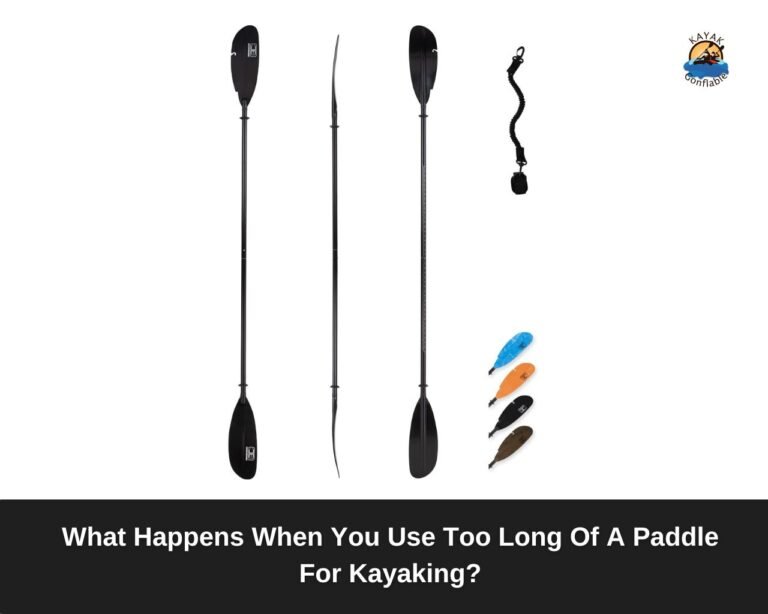Kayak Anatomy: Basic Parts of A Kayak
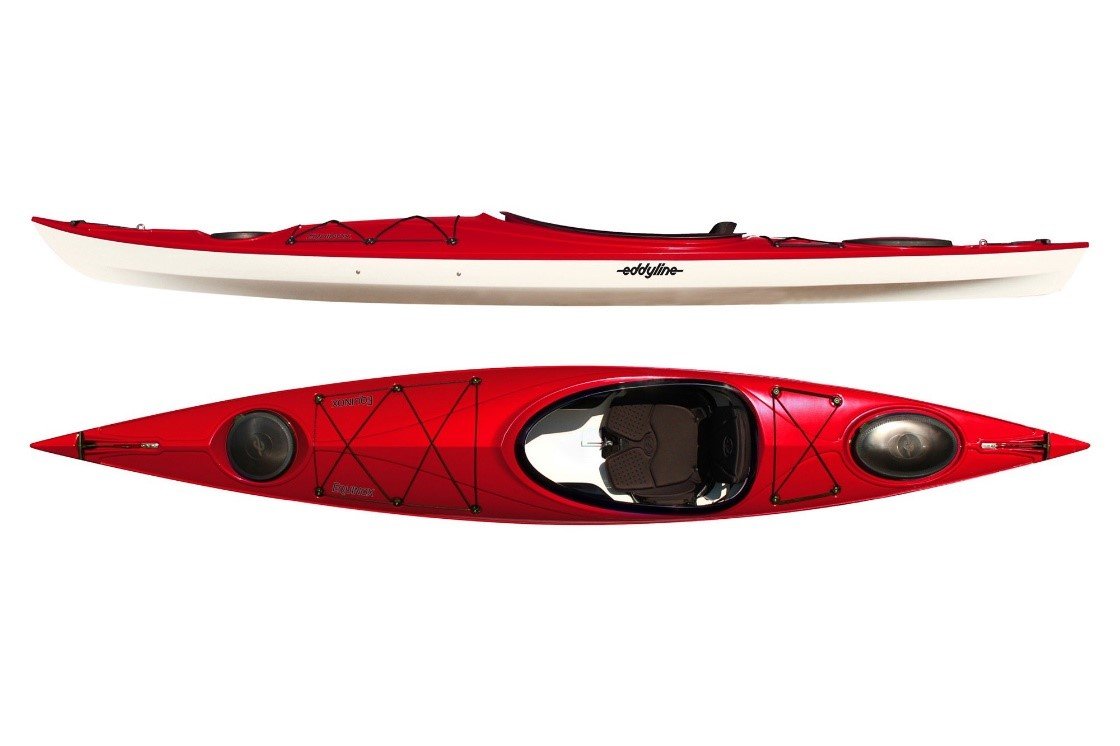
Kayak Anatomy
Kayaking can be a great way to spend a day outdoors. It is a relatively easy sport to learn and is perfect for people of all ages and fitness levels.
As with all great sports, kayaking becomes more popular every day as more and more people come to the water for the joys of exercising in nature’s beauty.
It is however crucial for all kayakers to understand their watercraft as kayaking is more than just paddling. A good way to start is to know all the parts of your kayak before hitting the water.
Knowing the parts of your vessel helps you better understand how it works and increases your confidence when you are paddling. We look into the parts of a kayak in this article.
What is a kayak?
A kayak is a small, lightweight watercraft that is propelled by a double-bladed paddle and is typically used for recreational fishing or paddling.
Kayaks are versatile watercraft that are enjoyed by people of all ages and abilities. They’re perfect for exploring lakes, rivers, and canals, as well as coastal areas.
Kayaks are relatively easy to transport and store, so they’re great for weekend getaways or longer vacations.
Kayaks come in various shapes and sizes and can be used for a variety of activities, including sightseeing, fishing, and paddling for fun.
They are made from various materials including plastic, fiberglass, wood, etc. Kayaks are usually made for a paddler but tandem kayaks for two paddlers exist.

Image Source: Sterling Kayaks
Parts of a kayak
The various parts of a kayak are explained below. As several types of kayaks exist, it follows that there are some variations in features, so some features are unique to some kayak types while others are general.
The Hull
The hull of a kayak is one of the most important components of the watercraft as it is the bottom of the kayak and helps it float.
It is responsible for transferring energy from the vessel to the water, and it is essential for stability, providing protection from the water, and maneuverability. It also helps to create the drag, which makes the kayak move through the water.
A correctly designed hull can make a great kayak a joy to use, while a poorly designed hull can make the vessel difficult or even impossible to use. There are two main types of kayak hulls: the displacement hull and the planing hull.
Displacement hull
This hull type is the more common of the two. Kayaks are typically built with a displacement hull, which is designed to keep the craft stable in the water.
The hull is made up of several layers of material, and it’s often designed to be flexible so that it can absorb shockwaves created by bumps or waves.
Displacement hulls are long, slim, and rounded and usually have a V-shaped keel to improve tracking. They help the vessel move fast and in a straight line so they are not ideal for areas with fast currents where rapid change in direction is performed.
Planing hull
This hull type is less common and usually found on whitewater kayaks. Planing hulls have a flat bottom keel and sharply angled sides.
They are used for navigating raids as they turn swiftly in the water and move very fast while moving and making turns. Kayaks with planning hulls are difficult to keep in a straight line as the vessel is made for making quick turns.
The Deck
The deck is the top of the kayak. The deck of a kayak is the platform on which the kayaker sits and uses his paddle to control the direction, speed, and movement of the kayak particularly in sit-on-top kayaks.
It is also where the paddler stores their gear, sits, and rests. In sit-inside kayaks, the deck usually covers the paddler’s legs and gear.
There are a variety of decks available on different kayaks, but most follow a similar design. The deck is typically composed of two or more panels that form a rectangular or oval platform.
The deck of a kayak may be covered by a rigid plastic hatch, or it may have open sides. In some kayaks, the deck is reinforced with additional stiffeners that run across the entire bottom, while in other kayaks, they are only located at the bow and stern.
The Cockpit
The cockpit of a kayak is perhaps the most important part of a kayak. It is an opening in the kayak’s deck that provides a comfortable place to sit and control the vessel.
It is usually enclosed on three sides, with an opening in the front for the paddler to enter and exit. Cockpits are the main feature of sit-inside kayaks and are non-existent in their sit-on-top counterparts.
The cockpit should be designed to provide good visibility and protection from the elements. The design of the cockpit should also allow easy access to all areas of the watercraft.
The cockpit is the main area in a kayak where the kayaker would spend most of his time and as such, it should be designed to give the operator a feeling of safety and comfort especially if the kayaker wants to paddle for a long time.
The cockpit has two primary purposes. The first purpose is for the operator to have a place to sit in order to control the vessel. The second purpose of the cockpit is to provide storage space for equipment, such as paddles and life jackets.
The most important measurement in deciding the cockpit design is the cockpit width. The wider the cockpit, the more comfortable it will be as it would make it easier to get in and out of the kayak.
Recreational kayaks usually have large oval cockpits for this very reason. Naturally, some kayaks like sea kayaks and whitewater kayaks have smaller cockpits that are either round or oval-shaped.
Small cockpits also have advantages of their own. These cockpits are better at keeping water out of the vessel and offer the kayaker more control over their watercraft.
The extra control and protection are really important as sea and whitewater kayaks are often used in more dangerous environments than kayaks with larger cockpits and any way to increase the safety of the kayaker must be prioritized.
The Rudder
The rudder is an important kayak part found on some kayaks. Kayaks rely on a rudder to keep them moving in the desired direction. Kayaks come with different types of rudders, but all share some common features.
The rudder is attached to the kayak’s stern and typically consists of a blade, a handle, and a frame. The blade is usually perpendicular to the kayak’s direction of travel and is used to change the kayaker’s orientation.
Even the slightest movement of a kayaker’s rudder can radically change the direction and speed of their vessel. With such precision, a well-adjusted rudder is essential for safe navigation.
Rudders are typically symmetrical, but some designs have asymmetrical blades. The frame provides structural support to the rudder and holds it in place.
Some rudders are mounted on a strut that allows the blade to pivot or rotate with respect to the kayak’s deck. The rudder is designed to pivot on the base of the blade and rotate around the axis of the strut.
Rudder blades are usually made from aluminum, carbon fiber, or graphite composite materials. Rudders can be controlled using foot pedals and are often removable or retractable.
The Stern
The rear or tail of a kayak is called its stern and it allows for stability and control when paddling. It can also be helpful when removing oneself from the kayak in a hurry. The stern is especially important as the cockpit and most of the kayak’s weight is usually located towards it.
The rudder which is a kayak part that improves the stability of the kayak and helps the paddler move in the desired direction is also attached to the watercraft at the stern so the stern must be designed with care as a poorly designed stern can lead to instability in the kayak, making it difficult to paddle.
The stern must be well-balanced for the kayaker’s safety. The stern should be heavy enough to provide stability but not so heavy that the kayak becomes a burden to carry.
The stern of a kayak is usually pointed though it is less pointed than the bow in some kayaks, particularly sit-on-top kayaks.
A good tip to keep in mind is that the length of a kayak is measured from the stern to the bow of the kayak so if you decide to verify the length of your kayak measure it from stern to bow.
The Bow
The front of the kayak is called the bow. The bow design allows for more stability while kayaking, making it easier to move through the water.
The bow is responsible for carrying the user and their gear through the water, and it must be able to withstand a great deal of abuse. The bow of a kayak is usually pointed.
Something to keep in mind to easily tell the bow apart from the stern is that first the cockpit will usually be located closer to the stern of the watercraft and also, the cockpit faces the kayak’s bow.
The bows of some kayaks especially sit-on-top recreational kayaks are more pointed than their sterns and this also helps tell the two apart.
The Keel
Kayaks are all about stability and being lightweight when on the water. One component that is essential for both stability and weight savings is the keel.
The keel is a broad, triangular piece of metal or plastic that sits at the base of a kayak’s hull. It helps to keep the kayak stable in the water and provides a measure of tracking stability.
It also helps to keep the kayak from tipping over. The keel could also be a long piece of wood, metal, or plastic that is attached to the center of the kayak’s bottom (hull).
It is important to note that the keel should not be confused with the rudder, which is a separate piece of wood that sits on top of the kayak and helps control the direction in which it travels.
The keel could be V-shaped as is common in sea kayaks and touring kayaks, rounded as is common in recreational kayaks, or flat as found in whitewater kayaks or other vessels using a planing hull.
The Skeg
The skeg is a small, triangular piece of wood or metal that is attached to the vessel at the rear of a kayak.
It helps the kayaker to keep the kayak straight while navigating through water that is the skeg helps to keep you pointed in the direction you’re paddling, preventing you from turning around in circles or otherwise losing control of your kayak.
The skeg also helps to prevent the kayak from capsizing by helping keep the vessel stable while in the water. They also provide stability when turning the watercraft. Unlike rudders, skegs don’t move left or right. Instead, they can be raised or lowered.
The Seat
The seat is another important part of a kayak. It is usually located in the cockpit (for sit-inside kayaks) and provides a place for the kayaker to position himself for the paddling exercise to come.
As kayaks are made from different materials, the level of comfort kayak seats provide greatly varies from one kayak to the other depending on the material the seat is made from.
Some seats are rigid and made from hard plastic while others are more comfortable with foam and adjustable backrests. Kayak seats can also be built-in or removable.
Removable seats make the kayak lighter when you want to carry it but they also leave the seat in danger of damage if proper care is not taken.
The comfort kayak seats provide is very important as the more comfortable the seat is, the easier the paddling experience will be. Comfortable seats are also preferred for long kayaking trips.
The Importance of seats and sitting down in a kayak
Kayakers spend a lot of time in the kayak, sitting down and paddling. This can be a great opportunity to improve your health and well-being. Here are five reasons why you should sit in your kayak while paddling:
- Sitting in a kayak is a great way to improve your blood circulation.
- It also helps to reduce lower back pain.
- Sitting in a kayak will help to improve your balance and coordination.
- Sitting in a kayak will give you more power and stability for paddling.
- Sitting in a kayak will help to strengthen your core muscles as you exercise while paddling.
Hatches
A hatch is a small opening in the deck or top of a kayak that is often used to store and retrieve gear, or to provide a place to rest your head while you kayak.
They can also be used as a place to store your paddle when it is not in use. Hatch openings are quite common on fishing kayaks and can be handy for storing a fishing net or rod.
There are two main types of hatches: hard hatches that are screwed on the kayak and rubber hatches that stretch over the opening in the deck. Whichever type you have on your kayak, it must be watertight when closed to keep your gear safe and dry.
Deck Lines
As per their name, these are the ropes or lines found on a kayak’s deck. There are several deck lines each named based on the role they perform. Deck lines include:
Gear Storage Lines
Kayaking is a great activity for people of all ages, but it can be difficult to carry everything you need with you. Fortunately, gear storage lines on a kayak can make the process a lot easier.
These lines (typically bungee cords crossed in an X shape across the deck in front and behind the cockpit) attach to your kayak and hold everything from your paddle to your food and water supplies.
They’re simple to install and remove, and they make carrying everything you need on your kayak much easier. Gear storage lines are a great way to keep your gear organized and manageable while you’re kayaking.
They can prevent you from having to search for your paddle or fishing rod in the middle of the river, and they can also help keep your kayak stable while you’re fishing.
They are common on sit-inside kayaks but are also sometimes found on sit-on-top kayaks.
Perimeter Lines
Perimeter lines are deck lines that run along the perimeter or boundary of your kayak from bow to stern. These safety lines are tightly fitted to the kayak but loose enough for the kayaker to slip their fingers inside and grab hold of them.
Perimeter lines are very important in every kayak as they give you a place to grab and hold onto your kayak in the event of a capsizing. Grabbing the kayak through perimeter lines will help you be close to the vessel and possibly right it to continue your journey.
Perimeter lines are also safety equipment that can be used to rescue others who have capsized or otherwise fallen in the water.
By moving close to the person in the water, kayakers can rescue them by letting them grab the perimeter lines of their watercraft to help keep the person afloat until help comes.
Rudder Lines
Rudder lines are another set of lines found on the deck and these lines are often present on kayaks that have retractable rudders. Rudder lines help you keep your kayak on track by providing an easy way to adjust the direction of the vessel from the cockpit.
They are used to control the rudder for safer navigation. This can be especially helpful when you’re navigating around rocks or other obstacles.
Hatch Tethers
Hatch tethers are small cords used to attach hatches to the deck. A well-secured hatch cord ensures the hatch remains fastened to your kayak deck and that you don’t mistakenly remove it while doing one thing or the other while kayaking.
Hatch tethers also help protect your gear or other things you might have stored in the hatches by ensuring you don’t lose your hatches on the water.
Toggles or Handles
Handles are a feature on kayaks that can make them more maneuverable in the water. Some kayakers prefer to use toggle switches as handles, while others prefer hand-held levers.
Toggle switches are convenient because they are located right next to the seat, while hand-held levers are more comfortable because they require less arm strength.
A kayak’s bow and stern are also often equipped with toggle or handle systems that make carrying the kayak easier.
These systems allow the kayaker to easily move the kayak from one location to another, and can also be used to store the kayak when not in use.
Foot Braces
Foot braces are part of sit-inside kayaks and provide more stability and control while paddling. They also make the kayak easier to move around in.
They allow for a more comfortable and secure sitting position, making the experience more enjoyable and safer.
Foot braces are often adjustable which makes them even more useful. Foot braces should not be used if the kayaker is using a recirculating bail system.
Importance of Foot Braces
- Foot braces offer a more stable platform than a traditional kayak.
- They allow you to keep your feet inside the kayak during tough turns.
- Foot braces can improve your paddle technique, which can make you faster and more efficient in the water.
- Foot braces also add an element of safety to kayaking by providing support if you fall out of the kayak.
Bulkheads
Bulkheads are a common feature on sit-inside kayaks. They are the walls inside a kayak at the front and back. They serve as a barrier between the kayaker and the water, preventing splashback and other water turbulence.
Bulkheads are always waterproof and help separate the kayak’s cockpit from the gear storage compartments. They also help prevent the vessel from being completely flooded should you capsize.
A good thing about bulkheads is that they are less likely to cause chafing or rubbing and they are quite comfortable when wet.
Thigh Braces
Thigh braces are found in sit-inside kayaks. Thigh braces are small pieces of equipment that attach to the inside of your kayak’s seat and fit snugly against your thighs to provide stability and support.
They can also help prevent thigh rubbing while sitting in your kayak which could be very uncomfortable if you are kayaking for a long time.
Thigh braces are often adjustable to fit different body types and like foot braces, they help increase the paddler’s control over his vessel. Some kayaks use knee braces in place of thigh braces but they have the same principle as thigh braces.
Coaming
Coaming is the technical term given to the rim of the cockpit. This kayak part thus exists only on kayaks that boast a cockpit. The coaming is curved so you can hook a spray skirt into it. A spray skirt is a waterproof kayaking gear fitted to the cockpit that helps keep water out of the kayak.
Compass Recess
The compass recess is a nook in front of the cockpit where the paddler can put and easily access a compass. They are common on the deck of sea kayaks and touring kayaks. With a compass in the compass recess of your kayak, you can find your way with ease.
This is a perfect tool for those new to kayaking and for experienced kayakers who want an easy way to get around, especially if they only know the coordinates of their intended destination.
The compass can also be useful in finding your way should you get lost and find yourself on strange waters.
Scuppers
Scuppers are found on sit-on-top kayaks. There are holes through the kayak from the deck to the hull. Scuppers are useful in draining water from the kayak’s deck and are especially useful in choppy water.
Scuppers can however be a disadvantage as they can bring water on deck through those very holes when you don’t need it.
To deal with his kayakers should make use of rubber plugs to block the scuppers when they don’t need drainage. Scuppers can also be useful in locking your kayak as they provide places to run the locking cable through the vessel.
Footwells
Footwells are another feature of a sit-on-top kayak. They provide an enclosed space for your feet and can make your kayaking experience more comfortable and enjoyable.
They also help to keep you stable when you are sitting on the kayak. Sit-on-top kayaks typically have several footwells to suit kayakers of various heights since footwells are not adjustable. Some sit-on-top kayaks eliminate footwells and replace them with adjustable foot braces.
High-Low Seat
This interesting feature is typically part of fishing kayaks though some other kayaks may possess it. The high-low seat is an adjustable seat that allows the kayaker to decide the height level of his kayak relative to the surroundings and the task at hand.
When the seat is adjusted to a low position, it offers more stability to control the watercraft so his position is ideal when paddling the kayak.
A high position is however better for fishing which is primarily why fishing kayaks usually have this feature. A kayak is made up of different parts each serving a specific purpose that all work together to create a stable and safe experience when paddling.
Understanding how each piece functions will help you select the right kayak for your needs and ensure you are getting the most out of your experience on the water.
It is important to be familiar with all the parts of a kayak before taking it out on the water as that familiarity will help you know what to do and which kayak part should be tweaked in a given situation to ensure your safety.
Be sure to always wear a life jacket and practice safe kayaking habits when kayaking. So, what are you waiting for? Get out there, find the perfect kayak for you and start paddling!
Frequently Asked Questions
What are the different types of kayaks?
Kayaking is a sport that can be enjoyed by people of all ages and fitness levels. Kayaks come in a variety of shapes and sizes, depending on the user’s needs.
They can be versatile vessels that are perfect for short trips or long expeditions, depending on the kind of kayak that is selected.
Types of kayaks include recreational kayaks, touring kayaks, whitewater kayaks, sit-on-top kayaks, fishing kayaks, and sea kayaks. Recreational kayaks are the most popular type because they are versatile and affordable.
What is the bottom of a kayak called?
The bottom of a kayak is called the hull. The bottom of a kayak is typically made from a hard, waterproof material that helps keep the kayaker upright and provides stability in the water.
Some kayaks also have built-in rests for your feet, which can make it easier to brace yourself against waves while paddling.
What do you call the holes in the kayak?
The holes in a kayak are called scuppers or scupper holes. They are openings found on the kayak from deck to hull that primarily exist to help drain water from the kayak.
When not in use, scupper holes should be plugged with rubber plugs so they don’t let the deck become flooded. They can also be useful when locking a kayak as you can run your locking cable through the holes to help secure the watercraft.
What side of the vessel is the bow on a kayak?
The bow is the front of the kayak. It is the front end of the vessel that the kayaker faces while paddling the vessel.
The cockpit also faces the bow. In some kayaks (such as sit-on-top recreational kayaks), the bow is more pointed than the stern (the rear of the kayak).

